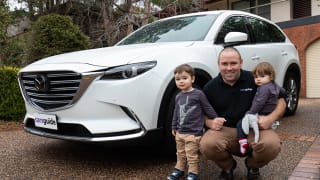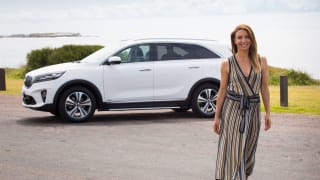Let’s get a few things straight. I love life, I love cars and driving, I love being the age I am and have no serious regrets. I also have no plans for mass procreation, but I did just specifically request to park a Kia Carnival in my driveway for an extended period of time.
Yes, the emergence and booming popularity of the SUV has meant that the traditional people mover is a bit on the nose, but I’ve always felt the current Carnival does a good job of swimming against the tide by doing a stellar job of moving eight people, while still being car-like to drive and amazingly managing to look pretty cool at the same time. Go and have a proper look and drive before roasting me in the comments.
Also backing me up is the fact that the current Carnival has built a bit of a cult following in the CarsGuide office. Everyone who uses one with their family seems to come back raving.
It is the top seller in the mainstream people mover class by a factor of 4:1, but is outsold by its smaller but more fashionably shaped Sorento SUV sibling by 2:1, even though they sit pretty close on price and spec.
If it’s the better tool, why don’t more of us choose it? Kia Australia has kindly offered us three months with the top-spec Carnival Platinum diesel to test the theory.
It’s also the most logical next step in my personal exploration of family cars, building on our time with the Tiguan, Escape, CX-5, CR-V, Golf R wagon, Santa Fe and CX-9 to date.
It’s indeed a bit OTT to ferry around my two toddlers, but with an increasing number of grandparents, aunties and uncles, not to mention little chums lining up to ride along too, I’m confident we’ll put it through its paces.
The Carnival continues to be available in S, Si, SLi and Platinum trim levels, each with a choice of 206kW/336Nm 3.3-litre petrol V6 or 147kW/440Nm 2.2-litre turbo-diesel for an extra $2,500.
One key difference from the Sorento is that there’s no all-wheel drive option for the Carnival, but we’ll let you know if we miss it.
It was last updated in May 2018 after first appearing in February 2015, which brought improved safety features across the range, range-wide Apple CarPlay and Android Auto, a new eight-speed transmission and a bunch of other detail tweaks.
Our Platinum diesel is the first of the MY20 models, which actually doesn’t bring any changes for the 2020 model year, even down to the $62,790 list price.

If you’re really into Carnival trivia, you’ll be interested to know that the most significant change since its 2018 facelift has been the deletion of the portable LED torch from the Platinum’s cargo area.
Importantly, all current Carnivals meet my personal safety requirements with curtain airbag coverage for all three rows, AEB and a maximum five star ANCAP safety rating. The Platinum also adds rear cross-traffic alerts and high-speed blind-spot monitoring. It would be nice to see side airbags covering all three rows, but this is still rare among non-premium branded products.
But the big thing we’re looking to embrace is its bigger size and more practical shape than your typical large SUV.
It’s much more of the latter when it comes to moving from our previos CX-9 though, given it’s just 4cm longer, within 2cm wider and actually slightly lower than the CX-9 if you account for the Carnival’s roof rails.
It’s a different story if you’re shopping between the Carnival and its Sorento sibling though, with the SUV being 32cm shorter, 10cm narrower and 7cm lower, which could make a significant difference when it comes to parking and general manoeuvrability.

I also know Grandma is looking forward to seeing if she can finally sit comfortably between the two child seats on the second row, but this test will have to wait given she’s out of action with a foot operation for the next couple of months.
As with all our long term test cars, the first test is the fitment of these child seats. It’s got the important ISOFIX mounts in the outboard second row positions, and unlike the CX-9, they’re easy to access without being obscured by the seat material.
Like the CX-9 though, I found that the top tether strap for our 0-4 years seat wouldn’t reach the latch on the back of the second row when trying to fit it in rear-facing configuration. Fortunately this coincided with Miss 15 months being big enough to swap around to forward facing, but extension straps are readily availalble for anyone met with the same issue.
Lifting the seats aboard highlighted just how much bigger an opening is created by the sliding rear doors. It may seem trivial, but when you’re reaching through those doors to pick up things off the ground, load heavy objects and generally trying to avoid contact with the perimiter, a bigger opening is always better. And don’t worry, the side windows wind down like any conventional door.
The fact that the top two grades of Carnival feature one-touch power operation for both sides only accentuates this practicality. Hit the key on approach and its open and ready for you. Hit the button on the overhead console, and its ready and open for gransparents who might otherwise be confused by its sliding mechanism. Easy. Mr two-and-a-half also gets a real kick out of what he’s nicknamed “robot doors.”
Another detail all rear occupants really benefit from is the deep tint for all rear windows and retractable sunshades for both back rows (!!!). Your kids will be safe and comfortable from sun glare as much as you’re able to ferry around celebrities unnoticed.
It’s the boot that’s the real revelation though. With the third row folded flat, there’s a sense I could park my Toyota Echo in there. At the very least, the extra height between floor and roof means we can load any of our strollers without collapsing them. Try that in any SUV smaller than a LandCruiser!

Back to back with the CX-9 Azami with its nappa leather and genuine woodgrain, my first impressions are that the materials don’t feel quite as opulent, and it’s not quite as quiet to drive, but it’s so much better than you probably expect for a box on wheels and a world ahead of the commercial-based passenger vans you might have grown up with.
It’s more in line with the Santa Fe we lived with before the CX-9 actually, which should come as no surprise given it shares much of its underpinnings, engine and transmission with the Hyundai’s large SUV from the same parent company. This comparison is therefore also valid for the Sorento with equal component commonality.
One detail that ages the Carnival is the lack of head up display, but there’s still ample digital instrumentation behind the steering wheel.
You might also look for a wireless phone charger, but it would likely rarely get used given the need to connect via USB to access the Android Auto smartphone mirroring (or Apple CarPlay if that’s your preference).
I’m interested to see what difference is extra 200kg of weight over the Santa Fe makes to its real-world fuel consumption. Given our near-10,000 km of experience with the same-engine and transmissioned Hyundai, we’re equipped to tell that story best.
Our Carnival arrived with just 373km showing on the odometer, so I don’t expect its early kilometres to reveal its true potential or go near its 7.6L/100km official combined figure. But, our first 1607km this month of general mixed driving has returned an impressive 8.89L/100km. Not bad considering the Santa Fe’s six month average of 8.48.
Acquired: July 2019
Distance travelled this month: 1607km
Odometer: 1980km
Average fuel consumption for July/Aug: 8.89L/100km (measured at the pump)
















